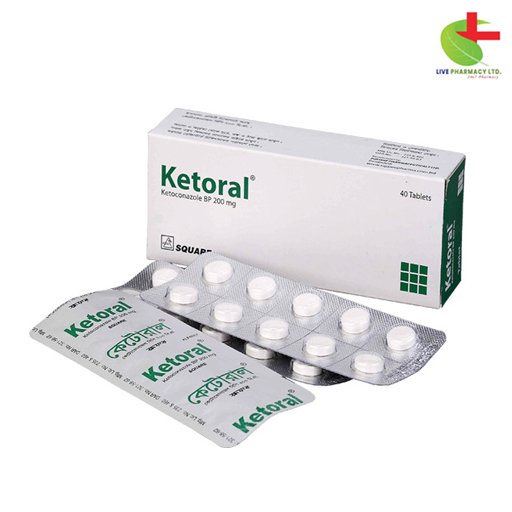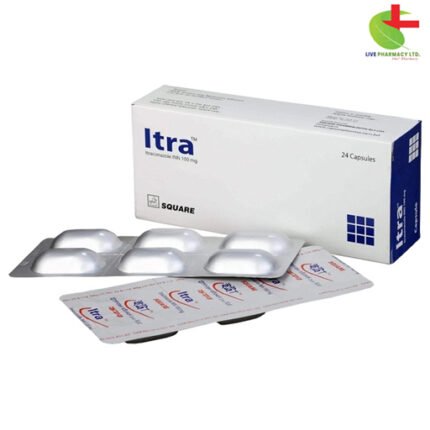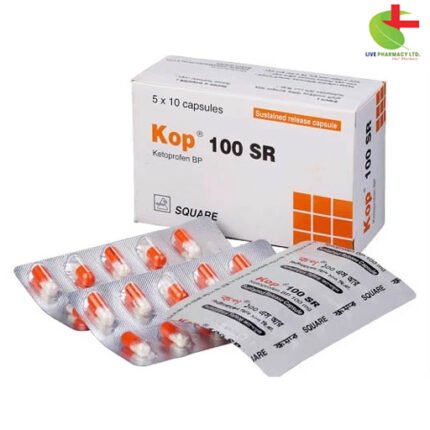Ketoral 200
- Experience relief from fungal infections with our range of Ketoral products.
- Target specific conditions like seborrhoeic dermatitis and dandruff with our specialized shampoos.
- Treat dermatophyte infections of the skin effectively with our Ketoral creams.
- Our Ketoral tablets provide systemic relief for various mycoses, including vaginal candidiasis and systemic fungal infections.
- Backed by rigorous research and dosage guidelines, our products ensure optimal treatment outcomes with a focus on safety and efficacy.
 Brand
Brand
|
Square Pharmaceuticals PLC |
|---|---|
 Generics
Generics
|
Ketoconazole |
Indications
Shampoo: Ketoral shampoo effectively addresses infections involving the yeast Malassezia, previously known as Pityrosporum. It’s specifically designed for conditions like localized pityriasis versicolor, seborrhoeic dermatitis, and pityriasis capitis (commonly known as dandruff).
Cream: Ketoral 2% cream offers topical relief for dermatophyte infections of the skin, including tinea corporis, tinea cruris (commonly known as dhobie itch), tinea manus, and tinea pedis (also known as athlete’s foot) caused by Trichophyton spp, Microsporon spp, and Epidermophyton spp. It’s also effective against cutaneous candidosis, candidal intertrigo (sweat rash), tinea versicolor, and seborrhoeic dermatitis caused by Malassezia spp.
Tablet: This medication is crucial for treating various superficial and deep mycoses, including skin, hair, and nail infections caused by dermatophytes and/or yeasts. It’s also beneficial for managing yeast infections of the mouth and gastrointestinal tract, vaginal candidiasis, and systemic mycotic infections. Additionally, it serves as a maintenance treatment to prevent recurrence in systemic mycotic infections and chronic mucocutaneous candidiasis, and as prophylactic treatment for patients with compromised immune systems.
Ketoral Bar: Ideal for combating all types of body fungus.
Pharmacology
Ketoconazole acts by inhibiting 14-α-sterol demethylase, an essential enzyme for ergosterol synthesis in fungi. This inhibition leads to increased fungal cellular permeability and impairment of membrane-bound enzyme systems, ultimately hindering fungal growth.
Dosage & Administration
Shampoo: Apply ketoconazole 2% shampoo to affected areas of the skin or scalp, leaving it on for 3 to 5 minutes before rinsing.
Cream: For tinea pedis, apply ketoconazole cream twice daily to affected areas. Treatment duration varies based on severity, typically lasting 1 week for mild infections and longer for more severe cases.
Tablet: Dosage and duration vary depending on the specific condition being treated, ranging from 5 days to several months.
Interaction
Shampoo and Cream: No interactions reported.
Tablet: Interactions may occur with certain medications, affecting their absorption or plasma concentrations.
Contraindications
Avoid in patients with known hypersensitivity to ketoconazole.
Side Effects
Side effects are generally mild and include local burning sensation, itching, or contact dermatitis with topical treatments. Rarely, oily or dry hair may occur with shampoo use.
Pregnancy & Lactation
Topical ketoconazole is considered safe during pregnancy and lactation, while oral ketoconazole is not recommended.
Precautions & Warnings
Caution is advised in patients with prolonged topical corticosteroid use and those with a history of liver disease.
Overdose Effects
No significant overdose effects expected with topical formulations.
Chemical Structure
- Molecular Formula: C26H28Cl2N4O4
Therapeutic Class
Ketoral falls under the category of drugs for subcutaneous and mycoses.
Storage Conditions
Store below 25°C, away from light and moisture, and out of reach of children.
Common Questions about Ketoral 200 mg Tablet
Ketoral 200 mg Tablet belongs to the class of drugs called azole antifungals, effectively halting fungal growth in various infections.













Reviews
There are no reviews yet.